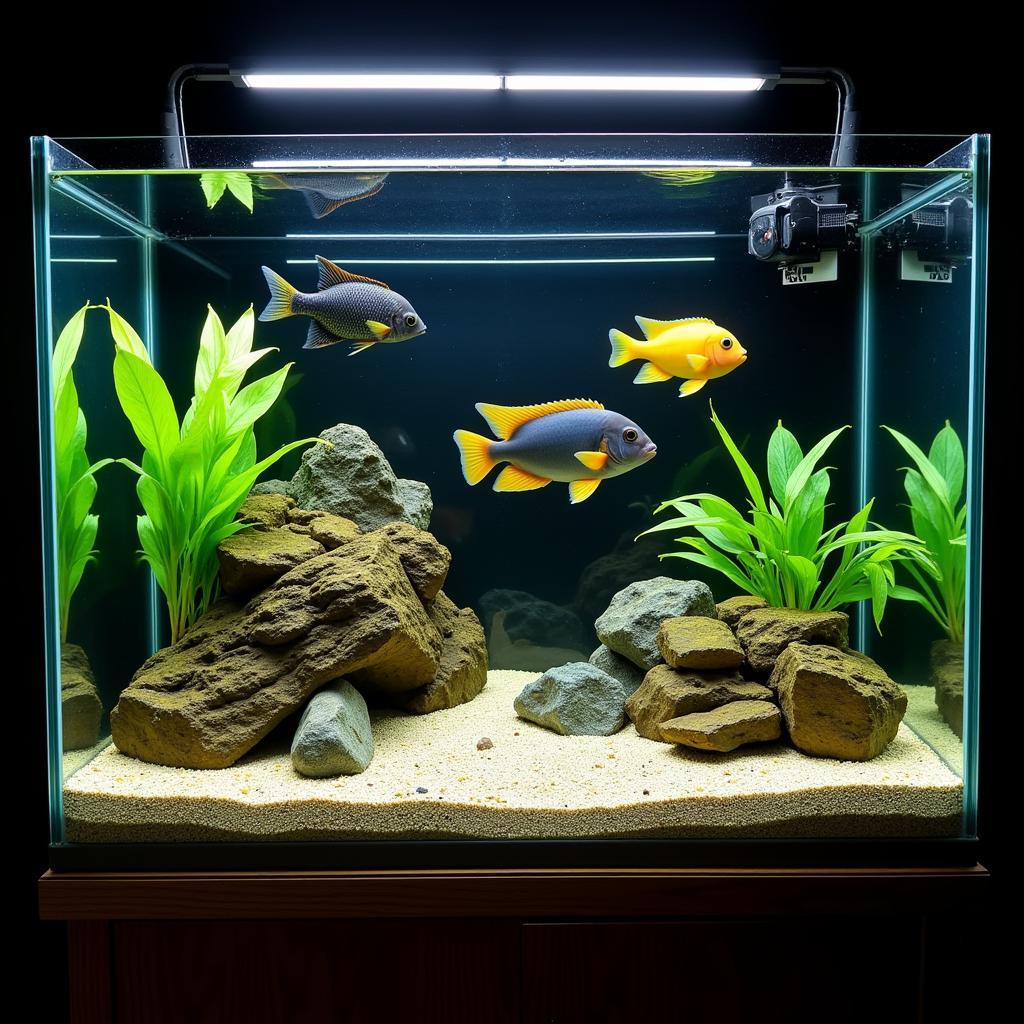The Ultimate Guide to African Cichlid Substrate
Choosing the right African Cichlid Substrate is crucial for the health and well-being of your cichlids. It influences water chemistry, encourages natural behaviors, and contributes to the overall aesthetic of your tank. This guide will explore everything you need to know about selecting, using, and maintaining the perfect substrate for your African cichlids.
Understanding the Importance of African Cichlid Substrate
The substrate isn’t just something to cover the bottom of your tank; it plays a vital role in replicating the natural environment of your African cichlids. Many cichlid species, especially those from Lake Malawi and Lake Tanganyika, engage in behaviors like digging, sifting, and rearranging the substrate. The right substrate facilitates these natural behaviors, reducing stress and promoting a thriving environment. Furthermore, the substrate can affect your water parameters, especially pH and hardness, which are critical for African cichlids.
Choosing the Right Substrate for Your African Cichlids
There are several substrate options available, each with its pros and cons. A popular choice is aragonite, a calcium carbonate-based substrate that helps buffer the pH and maintain the higher alkalinity preferred by African cichlids. Another option is crushed coral, which also buffers pH but can be sharper and potentially harmful to bottom-dwelling species. African cichlid water parameters are crucial to their survival. Sand is another excellent choice, providing a natural look and allowing for easy sifting and digging. However, be cautious with very fine sand as it can compact and create anaerobic pockets.
Different Substrate Options and Their Benefits
- Aragonite: Buffers pH, maintains alkalinity.
- Crushed Coral: Buffers pH, provides a natural look, however, ensure it isn’t too sharp for your particular cichlid species.
- Sand: Allows for natural digging behaviors, creates a natural aesthetic.
- Mixed Substrates: Combining different substrates can offer a balance of benefits.
What’s the best substrate for an african buttikoferi? It depends on their specific needs and tank setup. Research your specific species to determine the ideal substrate.  African Cichlid Tank Setup with Proper Substrate
African Cichlid Tank Setup with Proper Substrate
Maintaining Your African Cichlid Substrate
Regular maintenance is essential for keeping your substrate clean and healthy. Partial water changes help remove waste and uneaten food that can accumulate in the substrate. A gravel vacuum can be used to gently clean the substrate without disturbing the beneficial bacteria colonies that reside within it. Avoid over-cleaning, as this can disrupt the established ecosystem within your tank.
Tips for Maintaining a Healthy Substrate
- Perform regular partial water changes (25-50% weekly).
- Use a gravel vacuum to remove debris.
- Avoid over-cleaning.
- Monitor water parameters regularly.
“A well-maintained substrate is the foundation of a healthy and thriving African cichlid tank,” says Dr. Amani Zuberi, a renowned aquatic veterinarian specializing in cichlid care. “The right substrate, coupled with proper maintenance, will create a natural and stimulating environment for your fish.”
How to Choose the Best Substrate for Your African Cichlids
Consider the specific needs of your cichlid species when choosing a substrate. African cichlids tanganyika may prefer a different substrate than those from Lake Malawi. Research your species and consider their natural habitat. Also, think about the overall aesthetic you want to achieve in your tank.
Considering Your Cichlids’ Needs
- Research your specific species.
- Consider their natural habitat.
- Think about the overall aesthetics.
For example, understanding african cichlid breeding behavior can help you choose a substrate that supports their breeding habits. Some cichlids prefer to dig pits for spawning, while others may prefer rocky surfaces.
“Choosing the right substrate is an investment in the health and happiness of your cichlids,” adds Dr. Zuberi. “It’s a crucial element in creating a thriving and beautiful aquatic environment.”
Conclusion
Choosing the correct african cichlid substrate is paramount for the well-being of your fish. By carefully considering your cichlids’ needs, researching different substrate options, and maintaining a clean and healthy environment, you can create a thriving aquatic ecosystem that replicates their natural habitat. For vibrant fish like the african cichlid venustus, the right substrate is especially important. Remember to prioritize their natural behaviors and ensure your substrate supports their specific needs.
FAQ:
- What is the best substrate for African cichlids? The best substrate depends on the species, but aragonite, crushed coral, and sand are popular choices.
- How often should I clean my cichlid substrate? Regular partial water changes and gravel vacuuming are recommended.
- Can I mix different substrates in my cichlid tank? Yes, mixing substrates can offer a balance of benefits.
- Does the substrate affect water parameters? Yes, some substrates can buffer pH and alkalinity.
- How deep should the substrate be in my cichlid tank? A depth of 2-4 inches is generally recommended.
- What is the purpose of substrate in an African cichlid tank? It replicates their natural habitat, influences water chemistry, and encourages natural behaviors.
- How do I choose the right substrate for my specific cichlid species? Research the natural habitat and behaviors of your particular species.
Need help? Contact us! Phone: +255768904061, Email: kaka.mag@gmail.com Or visit us at: Mbarali DC Mawindi, Kangaga, Tanzania. We have a 24/7 customer support team.

